1. Understanding 310 and 310S Stainless Steel Pipes
How to Choose Between 310 Stainless Steel Pipe and 310S Stainless Steel Pipe: A Technical Guide
310 and 310S stainless steel pipes are austenitic alloys designed for extreme heat and corrosive environments. While they share similarities, their carbon content and performance in high-temperature applications differ significantly. This guide explains how to select the right grade for your project, supported by critical data comparisons.
2. How to Choose Between 310 Stainless Steel Pipe and 310S Stainless Steel Pipe - Key Differences: 310 vs. 310S Stainless Steel Pipes
The primary distinction lies in carbon content, which impacts weldability, creep resistance, and oxidation tolerance.
Chemical Composition Comparison
| Element | 310 (SS310/TP310) (%) | 310S (SS310S/TP310S) (%) | Functional Impact |
|---|---|---|---|
| Carbon (C) | ≤0.25 | ≤0.08 | 310S resists carbide precipitation during welding. |
| Chromium (Cr) | 24.0–26.0 | 24.0–26.0 | Enhances oxidation resistance at high temperatures. |
| Nickel (Ni) | 19.0–22.0 | 19.0–22.0 | Stabilizes austenitic structure for ductility. |
| Manganese (Mn) | ≤2.0 | ≤2.0 | Improves hot workability. |
| Silicon (Si) | ≤1.5 | ≤1.5 | Enhances oxidation resistance. |
| Density | 7.9–8.0 g/cm³ (±1–2%) | 7.9–8.0 g/cm³ (±1–2%) | Negligible weight difference. |
3.How to Choose Between 310 Stainless Steel Pipe and 310S Stainless Steel Pipe- How to Evaluate Mechanical Properties
Mechanical Properties at Room Temperature
| Property | 310 Stainless Steel Pipe | 310S Stainless Steel Pipe | Implications |
|---|---|---|---|
| Tensile Strength (MPa) | 515–760 | 485–690 | 310 is stronger for load-bearing high-heat applications. |
| Yield Strength (MPa) | 205–310 | 170–275 | 310 suits structural frameworks in furnaces. |
| Elongation (%) | 40–50 | 40–50 | Both offer excellent ductility for forming. |
4. How to Choose Between 310 Stainless Steel Pipe and 310S Stainless Steel Pipe- How to Assess High-Temperature Performance
310 and 310S excel in temperatures up to 2100°F (1150°C), but their oxidation resistance varies:
Oxidation Resistance in Air
| Temperature | 310 Pipe Performance | 310S Pipe Performance |
|---|---|---|
| 1500°F (815°C) | Excellent | Excellent |
| 2000°F (1093°C) | Good | Moderate |
| Cyclic Heating | Resistant | Prone to scaling |
Key Insight: 310’s higher carbon improves creep strength but reduces weldability. 310S is better for cyclic thermal stress.
5. How to Choose Between 310 Stainless Steel Pipe and 310S Stainless Steel Pipe- How to Select Based on Application
Ideal Applications for 310 Stainless Steel Pipe (SS310/TP310)
- High-Temperature Structural Components: Furnace parts, radiant tubes, and boiler systems.
- Load-Bearing Systems: Industrial oven racks and heat-treating equipment.
Ideal Applications for 310S Stainless Steel Pipe (SS310S/TP310S)
- Welded Assemblies: Exhaust systems, heat exchangers, and refinery piping.
- Cyclic Heating Environments: Kiln linings and gas turbine components.
6.How to Choose Between 310 Stainless Steel Pipe and 310S Stainless Steel Pipe- How to Compare Costs and Fabrication
| Factor | 310 Stainless Steel Pipe | 310S Stainless Steel Pipe |
|---|---|---|
| Material Cost ($/ton) | 4,500–4,500–5,200 | 4,800–4,800–5,500 |
| Welding Requirements | Post-weld annealing needed | No annealing required |
| Machinability | Moderate | Moderate |
| Market Share | 40% of high-heat applications | 60% of welded thermal systems |
Cost Tip: 310S’s lower carbon reduces cracking risk, saving long-term maintenance costs.
7.How to Choose Between 310 Stainless Steel Pipe and 310S Stainless Steel Pipe- How to Follow Global Standards
| Grade | ASTM | EN | JIS | UNS |
|---|---|---|---|---|
| 310 (TP310) | A312 | 1.4841 | SUS310 | S31000 |
| 310S (TP310S) | A312 | 1.4845 | SUS310S | S31008 |
Note: TP310 and TP310S denote seamless/welded pipes per ASTM A312.
8. How to Maintain 310/310S Stainless Steel Pipes
- Avoid Chloride Exposure: Both grades are vulnerable to pitting in chloride-rich environments.
- Post-Weld Cleaning: For 310 pipes, anneal welds to restore corrosion resistance.
- Cyclic Heat Monitoring: Inspect 310S pipes for scaling every 6–12 months.
9. FAQ: How to Resolve Common Queries
Q1: Which grade is better for welding?
A: 310S (TP310S) due to lower carbon, minimizing carbide precipitation and cracking.
Q2: Can 310 pipes replace 310S in furnaces?
A: Yes, but only if welding isn’t required. For welded assemblies, 310S is safer.
Q3: Why is 310S more expensive despite lower carbon?
A: Tighter composition controls and higher demand in thermal systems drive costs.
Q4: Does the 1–2% density difference matter?
A: Rarely—only critical in aerospace or weight-sensitive designs.
10. Summary: How to Make the Right Choice
- Choose 310 (SS310/TP310) for:
- Extreme temperatures (>2000°F / 1093°C).
- Load-bearing, non-welded components.
- Choose 310S (SS310S/TP310S) for:
- Welded or cyclic heating systems.
- Budgeting for long-term maintenance savings.
The 1–2% density variance between grades has minimal practical impact but highlights their compositional flexibility. By aligning your choice with operational demands and standards (ASTM, JIS, EN), you ensure optimal performance and cost efficiency.
Keywords: 310 stainless steel pipe, 310S stainless steel pipe, SS310 pipe, SS310S pipe, TP310S stainless steel pipe, TP310 stainless steel pipe density 1%-2%.
This guide equips engineers and procurement teams with actionable steps to differentiate and deploy 310/310S stainless steel pipes effectively.


